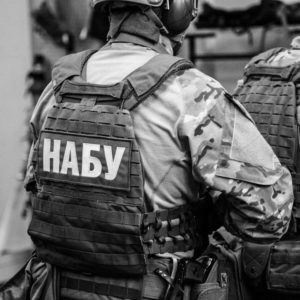
«I personally guarantee that we will honestly and decently do our job!»
Managing partner
Lawyer, Doctor of Laws, recognized media expert on legal issues, legal adviser to famous politicians and businessmen.
Search as tactical operation

Analyzing the practical activities of law enforcement agencies, we can conclude that investigative actions are carried out, separated from each other, and the chosen order of their conduct is often tactically incorrect. Due to the lack of time, the investigative actions available to the investigator are often carried out in isolation, and the sequence of their conduct is due only to the need to comply with the procedural form. Quite often, members of the investigative task force perform functional duties without coordinating them. All the above indicates the need for the use of forensic tactics, including tactical operations. Tactical operation serves as a means of "forming the necessary (favorable) investigative situation."
A.V. Dulov understands a tactical operation as a series of investigative, investigative and other actions carried out by an investigator during the investigation of crimes.
G.S. Fomina defines tactical operation as a complex, multifaceted concept, which is a dynamic (flexible) system of investigative actions, operational and investigative and other measures as the optimal means of solving tactical tasks, a specific form of cooperation, a special form of planning and due to the investigative situation and tactical task. According to D.Yu. Vyunnyk, this concept should be properly considered as a set of investigative actions, operational and investigative and organizational measures, combined into a system of interconnected components aimed at solving a specific task of investigating a crime.
Therefore, having analyzed the different approaches to the definition of this concept, we consider it necessary to consider a system of principles of this concept, which are divided into general and special.
The general principles of the tactical operation include the general principles of investigative activities, namely: legality, scientific validity, ethics, planning and others. Special principles follow from the peculiarities of the tactical operation as a specific tactical and forensic means of investigation. So they include the following.
Individuality in the development and conduct of a tactical operation is that such an operation should be carried out taking into account the specific conditions, circumstances of the case, the characteristics of the suspect, the relationship of the participants in the investigation and other significant factors.
The implementation of the principle of forensic analysis of the crime is that the tactical operation can be carefully prepared and successfully implemented only if the investigator, in preparation for it, forensic analysis of all available facts of the investigated offense. Such an analysis is a method of indirect knowledge of an illegal event and consists in identifying individual structural elements of a criminal offense, a separate study of each of the elements and their further consideration in the complex and relationship.
The complexity of the tactical operation is that the advantage of the tactical operation, compared with a separate investigative (search) action or operational-search measure, is achieved by combining several interdependent actions. Such a system of actions requires a combination of informational, organizational, logical, psychological and other aspects of the investigator's activity.
Increased organization of the tactical operation is to ensure a high level of organization of its preparation and implementation, based on its complex structure, a significant number of performers and limited time. This organization of the operation is expressed in a clear clarification by all participants in the operation of the general direction of their actions; preliminary division of responsibilities among themselves, etc.
The principle of full use of the capabilities of the participants of the operation to achieve its ultimate goal is that the available participants of the operation opportunities (procedural, operational and investigative, operational and technical, information and analytical and others) should be used as fully and effectively.
The dynamism of the tactical operation is manifested in the fact that this principle provides for the possibility and necessity of prompt change of the set of investigative (search) actions, operational and other measures that form such an operation, sequence, time and tactics of their conduct, the participants (participants in the operation). ) depending on the specifics of the investigative situation, which is formed at a certain time of the investigation.
The combination of collegiality and single-headedness during a tactical operation is that the advantages of a collegial approach to addressing such an operation helps to improve the quality of cognitive activity of its participants, ensure the fullest discussion of problems and reduce time for preparation and implementation. However, the organizing moment of the process of the operation should be considered the sole management of the operation by a specific official who conducts an investigation in criminal proceedings.
The principle of completion of a tactical operation by procedural fixation of results is that for each tactical operation the completeness of procedural fixation of actions performed within the operation, during which evidentiary information is obtained, must be ensured.
Thus, a search in the form of a tactical operation is a compulsory inspection of premises that have a large area or divided into many rooms, large areas, etc., with the help of a large number of entities carrying out investigative, operational and tactical measures, in order to finding and seizing a lot of hidden evidence of a crime, objects and values acquired by criminal means, subject to seizure, search for living persons and corpses, carried out in conditions of overcoming active opposition to the investigation.
Tactical operation "Search" may include a set of measures before the search, at the stage of direct search activities and after the search. These measures must be planned with the use of sufficient forces and means.
During the operational installation, not only the data on the searched object and persons living or working in it are clarified, but also the respondents themselves are checked for the possibility of their use during penetration into the premises, for other tactical or operational purposes. In addition, the operational installation allows to obtain and verify information that will facilitate the detection and investigation of crimes, obtain and verify information to search for suspects, identify the location and sale of stolen property, collect information necessary for other operational and investigative activities, and clarify data obtained from unspoken sources and officially from officials of state and public enterprises, organizations, institutions and the media.
As for visual observation, in addition to collecting information about the persons who are planned to conduct a search, it allows to identify the features of the object, the facts of movement of anything or anyone, the appearance of previously unknown persons and so on. All operational information must be immediately passed to the head of the tactical operation, who must decide on a direct search.
After the search, depending on the specific situation and the results of the search, the structural elements of the ongoing tactical operation may be:
- presentation for identification of things found during the search;
- interrogations;
- appointment of forensic examinations.
Sometimes, in cases of special complexity of the investigation, the investigator conducts a detailed inspection of the seized items and documents with the participation of a specialist or expert, drawing up a separate report.
After the search, depending on the situation, additional search operations may be carried out:
- visual observation;
- listening to telephone conversations.
In turn, the investigator can control and record the negotiations, as well as seize mail and telegraph items with their subsequent inspection and seizure. However, often these operational and investigative measures are carried out outside the tactical operation.
Execution of a special task to detect criminal activity of an organized group or criminal organization may be carried out in the form of covert investigative (investigative) action (hereinafter - NSDC) in accordance with Article 272 of the CPC within criminal proceedings or as a special operation of an operational unit. Such an operation is possible only in cases:
- it is necessary to disclose a serious or especially serious crime committed by an organized criminal group or criminal organization;
- when it is otherwise impossible to obtain operational and investigative information or documentary information.
In each case, the need to perform such a task creates a legend - a system of fictitious or partially true data that provides proper encryption of the operational worker.
An important tactic is to organize an ambush, which makes it possible to detain accomplices of suspects, identify and seize weapons of crime, objects, documents, valuables, and so on. The organization of the ambush should be carried out at a high professional level, as it is usually carried out in a situation of tactical risk with possible negative consequences. A well-prepared ambush can lead to significant success.
One of the important tactical rules is as follows: after a search, the tactical operation, depending on the specific situation, can be continued not only in case of failure, but also upon successful completion of this investigative action. This is due to the fact that the revealed facts will allow to return the criminal proceedings in another direction.
Thus, the investigative capabilities of the tactical operation "Search" allow to identify new episodes, well-veiled criminal connections, accomplices, means, instruments of crime, property obtained by criminal means and other circumstances relevant to criminal proceedings.
Since the tactical operation requires considerable effort, the actors involved in its implementation must have some stable external form of organization. This form is an investigative task force. According to the Instruction “On the Procedure for Establishing and Organizing the Activities of Investigative Groups and Investigative Task Forces”, the Investigative Task Force (hereinafter - SOG) is an organizational form of interaction between investigators and operative units of the police of Ukraine. investigators) and on his (their) written order (s) to carry out investigative (search) actions and covert investigative (search) actions by employees of operational units of the police of Ukraine in criminal proceedings, which are in the proceedings of the investigative units of the police of Ukraine.
If we consider this concept through the prism of the tactical operation "Search", SOG is a set of all subjects of the search in the form of a tactical operation, conducting research of the searched object in order to find and seize items, documents and valuables relevant to criminal proceedings . SOG, as a rule, consists not only of investigators and operatives, but also auxiliary forces, ie employees involved in the operation, only for the duration of such an operation. According to the Order of the Ministry of Internal Affairs "On the organization of response to reports of criminal offenses, other offenses, emergencies and other events and providing prompt information in the bodies and departments of internal affairs of Ukraine", such auxiliary forces may include:
- Employees of structural divisions:
- investigation (senior SOG);
- criminal investigation;
- fight against economic crime;
- combating drug trafficking;
- criminal police for children.
- Employees of research forensic centers;
- Public security police officers;
- Cynologists with service dogs;
- Precinct inspectors;
- Employees of other services.
When conducting a tactical operation "Search", SOG has the following structural elements:
- Tactical Operations Manager - a person who directs a search in the form of a tactical operation. It can be an investigator, head of the investigation department, prosecutor;
- Operational headquarters. In the most difficult investigative situations, during the tactical operation "Search", a special operational headquarters is created for the management of SOG, which performs the functions of leadership, coordination, support, collection and analysis of various types of information and more.
- Search group. A group of persons carrying out search activities in a separate area of the searched object. The group consists of a leader and members of the search team (operatives and specialists).
Thus, the most effective interaction of the investigator and operatives in the investigation of crimes is possible only in the SOG. Joint activities ensure high effectiveness of actions, their timeliness, savings and resources and determines the effectiveness of the investigation. When interacting in the form of SOG, employees have more favorable conditions for establishing mutual understanding with each other.
As mentioned earlier, the search consists of preparatory, working and final stages. The question of when the preparatory and working stages end is quite debatable. Thus, analyzing the forensic literature, we can agree with the views of RS Belkin and
EM Lifshitz, that search - a procedural measure carried out using measures of state coercion. That is why the working stage of this investigative action must coincide with the beginning of the application of coercive measures, ie with the moment of penetration into the searched object.
Preparatory measures are extremely important for the organization of the tactical operation "Search". These include:
- making an actual decision to conduct a search;
- collection and analysis of indicative information;
- search planning;
- obtaining the decision of the investigating judge;
- instructing SOG participants;
- preparation of search and other technical means;
- preparation of vehicles;
- preparation of means of communication;
- selection and ensuring the presence during the search of witnesses and, if necessary, the local housing authority;
- going to the place of search;
- coordination and control of search preparation;
- checking the readiness of all forces and means to conduct a search.
Making an actual decision to conduct a search in the form of a tactical operation is a complex procedure. To carry it out, the investigator must make not one but two decisions: to conduct a search and to conduct this search in the form of a tactical operation. Obviously, these two decisions should not be made at the same time, as the investigator, when deciding to conduct a search, cannot have data that would indicate the need to use such a form as a tactical operation. These data appear in the process of the following preparatory activities: collection and analysis of indicative information.
The amount of indicative information should be significantly expanded through both investigative and operational actions. The information should relate to the following categories of data:
- about the identity of the searched person;
- about the required items;
- about the places of the search;
- information on the activities of the enterprise, institution, organization.
The amount of data on the identity of the searched person, in preparation for the tactical operation "Search" should be much wider than those collected for a normal search. Since during a search in the form of a tactical operation there is more than one searched, it is necessary to collect information about each of them during the preparation. This information should be collected according to the following scheme:
- Collection of indicative data on each searched separately (profession and occupation, inclinations and features of leisure, lifestyle, usual routine, relationships with others, peculiarities of behavior in everyday life, connections and acquaintances, special skills, availability of firearms and special equipment connections with the criminal world, the presence of convictions, etc.);
- Collection of indicative data on all persons in the aggregate (information on personnel changes and personnel changes, the level of team cohesion, the division of the team into groups, the presence of informal leaders).
The depth of the study of such information, the level of its detail depends on the specific circumstances of the proceedings. Taking into account the above information, both further preparation and search tactics are built, the number and composition of SOG is clarified.
Information about the required objects should be formed depending on the type of such objects. For example, regarding the means, instruments of crime, objects, things and documents, it is necessary to obtain the following information: name of the object and its purpose, generic features (shape, size, material, color, details - for documents, etc.), individual characteristics (numbers, characteristics of use) , defects), etc.
Taking into account these characteristics, it is possible to build versions as to where, where the object is located, whether its shape, size, appearance can be changed, whether it can be disassembled, destroyed, what facts may indicate this.
When studying information about the searched object it is necessary to pay attention to the exact address and location of the building, purpose of the building and its components, attendance, number of permanent residents or employees, characteristics of the building planning and what material it is made of, possible ways of entering and leaving the premises, internal planning, exact boundaries of the territory where the search is to be conducted, the possibility of creating hiding places, etc. If the search is carried out in an open area, it is also necessary to find out the relief and vegetation of the area, its boundaries, etc.
Again, it should be emphasized that the amount of such information depends directly on the circumstances of the proceedings. To conduct a search in the form of a tactical operation, taking into account modern conditions, it is necessary to find out the following information: the presence of alarms, intercom, external and internal surveillance cameras, other technical means, security (its equipment, number), safes and more.
The source of all the above information may be the materials of criminal proceedings, expert opinions, expert advice, operational information and more.
Planning is a synthesis of the intellectual activity of the investigator, associated with the solution of mental problems, which aims to obtain the necessary information to establish the objective truth in the proceedings. Therefore, planning should be considered as a synthesis of cognitive and constructive activities of the investigator or prosecutor. Search planning in the form of a tactical operation can be divided into two parts:
- General planning of the search in the form of a tactical operation, which includes determining the start time of the search, its duration, the composition of the entire SOG and auxiliary participants, technical means, means of communication, ways to arrive at the place of search, ways to penetrate the searched object, determine the heads and members of the operational staff and search team, the number of search teams and the place where they will conduct search activities;
- Plan the actions of each search group. As the search in the form of a tactical operation, as a rule, is carried out at the enterprises, establishments, the organizations having the considerable area it is more expedient to carry out it on a weekday, thus the beginning of its carrying out has to coincide with the beginning of work of such object. This is due to the fact that in the morning there is a greater likelihood of finding all the necessary people in the workplace, as in most cases it is in the morning that meetings are held. Secondly, reception hours start a little later, so this will exclude the fact of participation of outsiders. Third, it will complete the search within the same period.
Regarding the need for a decision of the investigating judge, this measure was described in the first section of the scientific work, so we do not consider it appropriate to dwell on this action again.
The problem of ignorance of law enforcement officers of the circumstances of criminal proceedings needs a practical solution. The information must be transmitted through briefings, which clarify all the necessary information. However, the practical side of this issue indicates the ignorance of the members of the SOG on the specific proceedings. They seize all suspicious objects and documents, and sometimes all documents that, according to their subjective factor, matter. Such an inadmissible reception has a rather negative effect on the further investigation and use of those items that do contain evidentiary information. Excessive information remains an unnecessary ballast in multi-volume materials, which is reflected in the procedural terms, increases the time of acquaintance of the accused with the materials, and also complicates the ability of the investigator, prosecutor and court to navigate the materials.
An important element of the search as a tactical operation is the preparation of technical means. These include special sets of scientific and technical means, search, lighting, measuring and other devices, various probes, X-rays and more. Also, paying attention to the importance of the evidence obtained as a result of the tactical operation, it is necessary to provide SOG with video equipment for continuous shooting.
An important aspect for a tactical search operation is the provision of transport. Yes, this will ensure the suddenness at the initial stage, coherence in the departure of all members of the SOG, as well as reliable transportation of seized items and documents.
The head of the tactical operation must have the mobile numbers of all participants. This is due to the fact that when conducting a search in large areas, an important aspect of success is the rapid communication with subordinates. In addition, an important aspect is the early involvement of witnesses, as in sparsely populated areas this factor can cause significant problems.
Before conducting a search in the form of a tactical operation, the leader must be confident in the readiness of all forces and means. To do this, before the search, the head must convene an operational meeting of all responsible persons. Each of them must report on the readiness of forces and means to conduct an investigative action. Only after that it is considered permissible to conduct a search in the form of a tactical operation.
Speaking of the final stage of the search, its fixation in the form of a tactical operation has certain specific features. Thus, it is necessary to compile not only the search reports of individual parts of the searched object by each search group, but also the general search report. It must contain:
- place and date of the investigative action;
- start and end time;
- last name and position of the head of the tactical operation;
- the names of all participants in the search;
- the number and nature of the sites searched. Such plots must be assigned serial numbers, or indicate already used;
- number of applications (ie search protocols of individual sites);
- signatures of the person who drew up the report and the person responsible for the searched object;
- receipt of the responsible person on receipt of a copy of the protocol.
Thus, a search in the form of a tactical operation is an extremely complex and costly procedural action. However, it should be remembered that its proper conduct will help to fill the criminal proceedings with evidence and bring the perpetrators to justice.
Finally, it should be added that a search in the form of a tactical operation must be distinguished from such a concept as the interaction of investigative actions. Thus, under the same circumstances, the detection of traces of a crime or the need to obtain new information, you can conduct different investigative actions at the same time. In this case, they will complement each other.
For example, when a search reveals obvious traces of a crime (presence of a corpse, situation typical of a fight or rape, etc.), it will not be logical to display this information in the protocol of this investigative action, as it will not be admissible. In this case, it is necessary to inspect the scene. It should be noted at once that the search must be completed, as the simultaneous conduct of these two investigative actions is unacceptable.
This form of interaction and competition of investigative actions resembles a tactical operation. However, the fact is that the tactical operation is planned in advance, in a specific investigative situation. In this case, a number of interrelated investigative actions are unplanned and the decision to conduct another investigative action arises during the first. That is why it is very important to distinguish between these two concepts.
Thus, you can see the effectiveness and efficiency of the organization and conduct of tactical operations during the search.
Calculate the price of assistance:
1 question
Have other lawyers handled your case?
2 question
Are you in Kyiv or Kyiv region?
3 question
Do you need legal assistance urgently?
Managing partner
Lawyer, Doctor of Laws, recognized media expert on legal issues, legal adviser to famous politicians and businessmen.
Other articles on this topic:
call back
during the day




